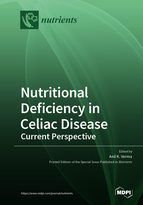Nutritional Deficiency in Celiac Disease: Current Perspective
A special issue of Nutrients (ISSN 2072-6643). This special issue belongs to the section "Nutrition and Metabolism".
Deadline for manuscript submissions: closed (9 July 2021) | Viewed by 70704
Special Issue Editor
Interests: celiac disease; gluten contamination; HLA-DQ distribution; other gluten related disorders
Special Issues, Collections and Topics in MDPI journals
Special Issue Information
Dear Colleagues,
Adherence to a strict gluten-free diet is the only effective treatment, to date, for celiac disease, with absolute regression in celiac-associated symptoms. A gluten-free diet is also recommended in other gluten-related disorders. Gluten is a mixture of storage proteins found in wheat and related grains that contains certain immune-potent fragments (prolamins), which are enough to inflict a toxic effect in the intestinal mucosa by triggering an immunological response in genetically susceptible individuals. However, gluten is a vital source, not only of protein, but also of various macro- and micronutrients. Banishment of gluten from the diet causes an alteration in the level of macro and micronutrients that eventually leads to nutritional imbalances, both in adult and pediatric celiac disease individuals.
Naturally gluten-free (grains, fruits, vegetables, etc.) and processed gluten-free products (commercial products) are advised as substitutes for gluten-containing food to patients affected with celiac disease and other gluten-related disorders. Although gluten-free products are enriched with nutrients however, they do not fulfill the required amount of nutrition; whereas gluten-containing products do. It is reported that gluten-free products contain a low amount of needed micronutrients (iron, folate, and vitamin B), fiber, and a higher amount of carbohydrates and lipids compared to gluten-containing products.
In recent years, nutritional complications have been reported in patients with celiac disease, which is a serious health issue, especially in growing children, that requires immediate action. For this Special Issue, we invite articles related to the nutritional aspects of celiac disease and other gluten-related disorders.
Dr. Anil K. Verma
Guest Editor
Manuscript Submission Information
Manuscripts should be submitted online at www.mdpi.com by registering and logging in to this website. Once you are registered, click here to go to the submission form. Manuscripts can be submitted until the deadline. All submissions that pass pre-check are peer-reviewed. Accepted papers will be published continuously in the journal (as soon as accepted) and will be listed together on the special issue website. Research articles, review articles as well as short communications are invited. For planned papers, a title and short abstract (about 100 words) can be sent to the Editorial Office for announcement on this website.
Submitted manuscripts should not have been published previously, nor be under consideration for publication elsewhere (except conference proceedings papers). All manuscripts are thoroughly refereed through a single-blind peer-review process. A guide for authors and other relevant information for submission of manuscripts is available on the Instructions for Authors page. Nutrients is an international peer-reviewed open access semimonthly journal published by MDPI.
Please visit the Instructions for Authors page before submitting a manuscript. The Article Processing Charge (APC) for publication in this open access journal is 2900 CHF (Swiss Francs). Submitted papers should be well formatted and use good English. Authors may use MDPI's English editing service prior to publication or during author revisions.
Keywords
- Celiac Disease
- Gluten
- Gluten-Related Disorders
- Nutritional Deficiency
- Gluten-Free Products
- Nutritional Imbalance







